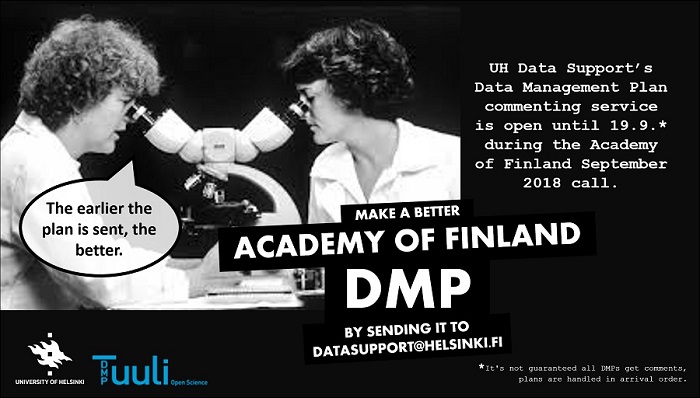What does a great data management plan (DMP) look like? The DataSupport at the University of Helsinki is regularly asked for examples and models of good plans. Here are the best pieces of advice for a researcher to create a great DMP.
(Tämä artikkeli on luettavissa myös suomeksi.)
The University of Helsinki’s DataSupport has provided a commenting service for a couple of years now. You may ask feedback from data support specialists about your data management plan by sending it to datasupport@helsinki.fi. In this work, I have seen some excellent plans. Because these plans cannot be shared, I would like to describe how does a brilliant data management plan look like.
Researcher’s checklist for making a brilliant data management plan:
- The plan has a clear structure, its content is easy to understand, it contains tables and an illustration of data flows. The plan does not repeat itself.
- The plan presents the data as a very valuable and useful output of the research.
- The plan presents the main risks of managing data and how to manage risks.
- The data management plan is clearly a part of the research plan. For example, the research plan lists the methods used, while data management plan lists the data used/produced using these methods. There must be no missing parts and no contradiction.
- From the plan it is easy to see that researcher know how to take good care of data. For example, all legislation or storage/transfer technologies do not have to be described in detail, but the relevant points of this project are clearly highlighted.
- The plan describes clearly who owns each part of the research data. It also tells how the ownership of the data to be produced is agreed.
- The plan clearly states that data will be shared and utilized in the future. Data publishing channels are known and have been used already previously (data citations are desirable).
- Data can also be kept safe. The backups, access control and the mutual responsibilities of the researchers are clearly described.
- Researchers are prepared for the selection of data to be archived and the proper destruction of unnecessary data.
- Data management is costly and lasts throughout the project. Costs consist of work, purchased services and equipment. This all is clearly stated in the plan.
The research funders wish to get a short plan (except EU). Short does not mean the same as little information. Making a concise plan is a skill you can practice. A data management plan for the own purpose of the research project is often 8 to 12 pages long. For ease of use clarity and conciseness are always as important.
Finally, I would like to remind you that data management plan is not done for the funder but for research. If you are not familiar with the concept, you could consider taking part in the course or workshop: http://libraryguides.helsinki.fi/rdm/courses-workshops.
Best wishes,
Mari Elisa Kuusniemi,
ORCID: https://orcid.org/0000-0002-7675-287X
Data Support, University of Helsinki
Ps. A data management plan can also be a research publication (please check examples here).
More information
- Courses & workshops: http://libraryguides.helsinki.fi/rdm/courses-workshops

